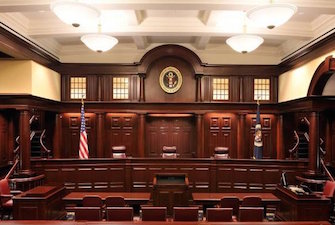 Cumberland Pharmaceuticals v. Mylan Institutional, LLC, (Fed. Cir. Jan. 26, 2017) (Before Moore, Reyna, and Taranto, J.) (Opinion for the court, Taranto, J.).
Cumberland Pharmaceuticals v. Mylan Institutional, LLC, (Fed. Cir. Jan. 26, 2017) (Before Moore, Reyna, and Taranto, J.) (Opinion for the court, Taranto, J.).
In a January 26, 2017 decision, the Federal Circuit affirmed a holding by the district court that a patent was not invalid for derivation or obviousness. Cumberland Pharmaceuticals, Inc. owns the ’445 patent, which describes and claims acetylcysteine compositions substantially free of chelating agents. It is listed in the Food and Drug Administration’s (FDA) Approved Drug Products with Therapeutic Equivalence Evaluations as covering Cumberland’s chelating-agent-free formulation of Acetadote®, an intravenous antidote for overdoses of acetaminophen. The product does not include Edetate (EDTA), which was previously included to stabilize the formulation.
When Mylan filed an abbreviated new drug application (ANDA) to market its own chelating-agent-free acetylcysteine, Cumberland sued Mylan for patent infringement. Mylan stipulated to infringement but asserted invalidity on two grounds: derivation of the claimed invention from someone at the FDA and obviousness. The district court rejected both challenges to the ’445 patent, holding that Mylan proved neither (1) that anyone at the FDA conceived of the claimed invention before the patent-named inventor nor (2) that there was a reasonable expectation that the claimed formulations, without any chelating agents, would succeed. Mylan appealed.
The Federal Circuit first examined Mylan’s derivation argument, which the court explained invokes the familiar rule that an applicant is not entitled to a patent if “he did not himself invent the subject matter sought to be patented.” (citing pre-AIA 35 U.S.C. 102(f)). However, the Court explained that to benefit from this rule the challengers must demonstrate both prior conception of the claimed subject matter and communication of the conception to the named inventor. The Court went on to emphasize that prior conception requires more than just a general goal or research plan. Instead, it must include a specific, settled idea. Namely, it must include the idea defined by the claim at issue. The party arguing derivation “must meet the heavy burden of proving its case by clear and convincing evidence.”
Here, Mylan had to show by clear and convincing evidence that the idea for the ’445 patent claim was conceived by someone at the FDA and communicated to Mr. Pavliv, the named inventor. The Court agreed with the district court that Mylan did not carry the burden of showing that someone other than Mr. Pavliv had conceived a “definite and permanent idea” of an EDTA-free Acetadote formulation. Mylan argued that Mr. Pavliv’s prior communications with the FDA, including the FDA’s request for justification of the inclusion of EDTA, required Cumberland to undertake research that would have inevitably led to the invention. However, this was not the same as a suggestion to remove EDTA. Derivation is not proved by showing conception and communication of an idea different from the claimed invention, even if that idea would make the claimed idea obvious.
The Court then analyzed Mylan’s argument that the ’445 patent is invalid for obviousness. Mylan relied on the EDTA-containing Acetadote® and its package insert–which, Mylan asserted, include or teach all of the elements of the invention except the removal of EDTA. Other references allegedly bridged the gap to reach the claimed chelating-agent-free version of an acetylcysteine product. The Court rejected Mylan’s argument, emphasizing that “[a] party seeking to invalidate a patent on the basis of obviousness must demonstrate by clear and convincing evidence that a skilled artisan would have been motivated to combine the teachings of the prior art references to achieve the claimed invention, and that the skilled artist would have had a reasonable expectation of success in doing so.” The “reasonable expectation of success” requirement refers to the likelihood of success in combining references to meet the limitations of the claimed invention. The district court found that the hypothetical relevant skilled artisan would not have reasonably expected a chelating-agent-free intravenous acetylcysteine formulation to succeed in being stable, which was a claim requirement. The Court held that the district court’s finding was not clearly erroneous. It noted that considerable evidence supports the finding that relevant skilled artisans believed that chelating agents were necessary, and that such artisans had no reasonable expectation of stability without such an agent.
Derivation is not proved by showing conception and communication of an idea different from the claimed invention, even if that idea would make the claimed idea obvious. The challenger must show by clear and convincing evidence that prior conception includes the idea defined by the claim at issue. The Court also stresses that in an obviousness analysis, the “reasonable expectation of success” refers to the likelihood of success in combining references to meet the limitations of the claimed invention.
[Troutman-Ad]
[Troutman-About]

![[IPWatchdog Logo]](https://ipwatchdog.com/wp-content/themes/IPWatchdog%20-%202023/assets/images/temp/logo-small@2x.png)


![[Advertisement]](https://ipwatchdog.com/wp-content/uploads/2024/04/Artificial-Intelligence-2024-REPLAY-sidebar-700x500-corrected.jpg)
![[Advertisement]](https://ipwatchdog.com/wp-content/uploads/2024/04/UnitedLex-May-2-2024-sidebar-700x500-1.jpg)
![[Advertisement]](https://ipwatchdog.com/wp-content/uploads/2024/04/Patent-Litigation-Masters-2024-sidebar-700x500-1.jpg)

![[Advertisement]](https://ipwatchdog.com/wp-content/uploads/2021/12/WEBINAR-336-x-280-px.png)
![[Advertisement]](https://ipwatchdog.com/wp-content/uploads/2021/12/2021-Patent-Practice-on-Demand-recorded-Feb-2021-336-x-280.jpg)
![[Advertisement]](https://ipwatchdog.com/wp-content/uploads/2021/12/Ad-4-The-Invent-Patent-System™.png)






Join the Discussion
One comment so far.
Scott Pierce
February 3, 2017 02:37 pmBob and Joe,
I enjoyed your article. I was particularly interested in the requirements of derivation, and the requirement for identity of the invention communicated, as opposed to obviousness, about which I wrote an article for the JPTOS shortly after the AIA was enacted: https://papers.ssrn.com/sol3/papers.cfm?abstract_id=1996684